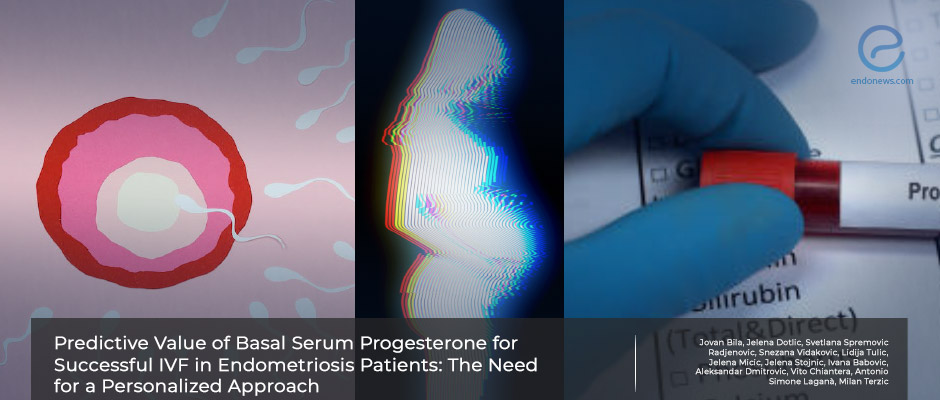Predictability of IVF success by basal progesterone levels on patients with endometriosis
Dec 20, 2022
Higher progesterone levels lead to higher IVF success in patients with endometriosis
Key Points
https://pubmed.ncbi.nlm.nih.gov/36294778/Highlights:
- Basal progesterone levels should be at least 0.7 ng/ml to reach a high chance of pregnancy on IVF cycles of patients with endometriosis.
Importance:
- The study highlighted the importance of serum progesterone levels in both treated and untreated patients of endometriosis on behalf of pregnancy rates.
What's done here:
- Women younger than 40 years old, primary infertile only related to endometriosis with no other factor and no gynecologic disease, have 3-15 antral follicles and regular menses with normal BMI have enrolled prospectively to the study.
- All patients had a diagnostic laparoscopy and those with more prominent than 3 cm endometrioma and ASRMIII/IV endometriosis have been grouped as G1 got operated on and took 6 months of GnRH analog. The rest with early stages grouped under the name G2 and directly have been led to IVF with no prior treatment.
- Demographic data, EFI scores, and day 3 AMH, FSH, LH, Estradiol, and progesterone levels have been noted.
- After ovarian stimulation ovarian response according to oocytes retrieved, number and quality of embryos, HCG positivity, and clinical pregnancy rates have been noted.
Key Results:
- In total 73 patients have met the criteria and 77 cycles have been applied.
- Pregnancy rates were significantly higher in younger women; they had a higher EFI score, higher basal serum levels of P4 and E2, lower FSH, and higher AMH.
- G1 pregnancy was accomplished more often if the basal serum levels of P4, E2, and AMH were higher. G2 has resulted in pregnancy when P4 and AMH are higher.
- Logistic regression analysis showed a correlation between higher P4 levels and pregnancy rates in both groups.
- the ROC analysis showed the cutoff level for P4 as 0.695ng/ml for operated patients and 0.7ng/ml for untreated patients.
Limitations:
- While it is a promising study for IVF success prediction, the low number of cycles taken into analysis resulted in low sensitivity and specificity indexes for analysis.
- There is a need for new studies with higher patient numbers or additive parameters to be checked.
Lay Summary
Endometriosis causes infertility in around 30-40% of all diagnosed women. Thus, strategies leading to more successful IVF results remain important.
In the prospective study by Jovan Bila, the menstruation day 3 levels of serum progesterone were questioned to have a predictive value. Women younger than 40 years old, primarily infertile only related to endometriosis with no other factor and no gynecologic disease, have 3-15 antral follicles and have regular menses with normal BMI have enrolled prospectively in the study.
All patients had a diagnostic laparoscopy and those with larger than 3 cm endometrioma and advanced stage endometriosis have been grouped and got operated on and took 6 months of GnRH analog. The rest with early stages grouped separately and directly have been led to IVF with no prior treatment. Demographic data, EFI scores, and day 3 AMH, FSH, LH, Estradiol, and progesterone levels have been noted. After ovarian stimulation ovarian response according to oocytes retrieved, number and quality of embryos, HCG positivity, and clinical pregnancy rates have been noted. In total 73 patients who have met the criteria, 77 cycles have been applied.
Pregnancy rates were significantly higher in younger women; had a higher EFI score, higher basal serum levels of P4 and E2, lower FSH, and higher AMH. In advanced-stage endometriosis patients, pregnancy was accomplished more often if the basal serum levels of P4, E2, and AMH were higher. On the other hand, the early-stage endometriosis patient group has resulted in pregnancy when P4 and AMH are higher.
Statistical analysis showed a correlation between higher P4 levels and pregnancy rates in both groups, and when the cutoff level for P4 was 0.695ng/ml for operated patients and 0.7ng/ml for untreated patients.
However, the sensitivity and specificity indexes are not enough to make it a valued predictivity test the point of view that the authors have might lead future studies to make the results clinically useful.
This paper was published in the recent issue of the Journal of Persian Medicine.
Research Source: https://pubmed.ncbi.nlm.nih.gov/36294778/
IVF progesterone P4

